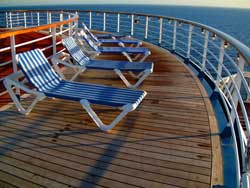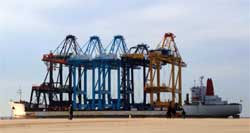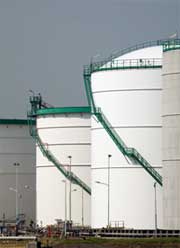| |
Issue 3 : August 2009 |
The green shoots of recovery, a false dawn or proof that no one knows what is happening. A spike in tanker charter rates was definitely a false dawn. The spike in the Baltic Dry Index seems to have been the result of Chinese games with iron ore purchases. The "end" of the recession in Germany, France and Japan could be quite green, though they have returned to achieving no growth after falling 10 to 15% over a year suggests a fragile sapling; more like the first plant after an ice age rather than spring.
Whatever the future holds the present is proving tough for all sorts of people. To make good on an earlier promise we take a brief look in this |
 |
issue at the cruise industry with comments on the woes besetting it at present and a short review of the triple whammy threatening is in one of our focus areas in Indonesia.
It gives hope that some are weathering the recession better than others so we have a quick look at Tank Terminals to admire their resilience.
Some business areas may take longer to recover than others, the new build market for container cranes could be one facing a prolonged slowdown in demand. Given the interest shown in the market by bankers recently, we thought a few words on the subject might be of interest to our readers. In this issue we have included a more fulsome introduction to our new partner Hambleton who we mentioned only previous in the last issue.
As always it will be interesting to get your feedback on our opinions and comments in this newsletter, just contact me on [email protected]. The quality of some of the replies is pushing us towards publishing the best though the newsletter is a bit small for a letters page!
|
Cruising through....
 |
|
Tough times are being reported in the "recession proof" cruise industry. Yields on cabins are down. At the annual jamboree in Miami in March this year, many were saying that the recession did not hit the core passenger markets for the high end cruises so badly. Perhaps it was tempting fate as someone came up with H1N1. The idea of being imprisoned on a ship for a few weeks, not being let ashore to view the reasons you boarded the ship in the first place or the view that a ship was a great place to transmit the virus to vulnerable groups provided another challenge for the operators. |
These problems strike just when ever larger number of cruise berths being brought into the fleet. Those green shoots which are doing the rounds have been spotted by some travel agents and lines need to grow quickly if the second quarter losses reported by some lines are not to turn into far worse news.
Those of us working in cruise terminals and destination management thought at one point we could skirt round such problems and our optimism was misplaced. The cruise lines are a clever bunch when they need to rethink how to generate more revenue and cut their operating costs. As a buyer the cruise companies are cutting into suppliers margins and in some cases their core operations. It is going to be interesting to see how this impacts shore excursion quality.
Those excursions were the focus of business plans that "worked" on Bali. Without them the investment and effective operation of terminals and facilities cannot be sustained. That and the negative impact on sentiment from the recent Jakarta hotel bombings means that shore side things are even more challenging in Indonesia right now than on board. There is a danger that one of the world's most perfect areas for cruising may remain a minority destination for some time to come. Given the beauty of the islands and the joy of the people, let us hope not.
Hambleton PacificThe agreement with Hambleton came in as hot news last time round. A little more time and a little more space can be devoted to them this time.
 |
|
Hambleton Risk Management Limited (Hambleton) has extensive international contracting and dispute resolution experience and has earned an enviable track record for identifying practical, imaginative and cost-effective solutions to major construction problems. |
Their established and expanding client network includes prominent international developers, operators, law firms and consultants, as well as leading general and specialist contractors and suppliers.
Perhaps best known in the fields of delay analysis, claims management and dispute resolution, Hambleton offers a full range of risk management and mitigation services including:
 |
Pre-Contract Advice |
 |
Construction Insurance |
 |
Project Commercial Management |
 |
Contractual Claims & Delay Analysis |
 |
Dispute Resolution & Expert Witness Services |
 |
Management Systems |
 |
Pre-acquisition and other services |
Hambleton's approach is flexible, objective and 'hands on' in style, and clients can expect all assignments to receive the personal attention of a Director, from initial consultation until completion. Hambleton has a wide range of skills at its disposal, and is able to deploy technical resources and experience tailored to the particular problem and to the prompt and economic identification of the optimum solution to that problem. We have enjoyed working with the Hambleton team in the past and looking forward to introducing them to our friends and working with them more closely in the future.
Container Cranes and Port Handling Equipment
There are sometimes surprises in the nature of enquiries that you get from investment banks. Recently for example there has been a flood of bankers wanting to talk about container cranes. To be more accurate they do not want to talk about the cranes; they are interested in learning more about the people who make them. If it were just one or two bankers with similar questions it would not be worthy of mention. It would be best to describe it as a flood of bankers asking the same questions.
 |
|
The nature of the container cranes market makes the enquiries even stranger; twenty years ago there were many suppliers for items of equipment that while large and having sophisticated control systems, are quite easy to build. They can be built without special equipment or factories applying a range of different approaches; in Indonesia I saw one built efficiently with a 40t crane and a welding set or two on waste land behind the terminal |
it was destined to serve. Today when there is a single supplier building 70% of the ship to shore cranes and 50% of the support cranes hearing from so many bankers must suggest something, but I will leave it to you to decide what.
The fall in container volumes across the world that has been seen in the last year (and in the last two years in the US) will mean that ports will have substantial excess container handling capacity when the upturn comes. Perhaps 25% excess capacity, perhaps rather more if many ongoing developments are completed and cranes delivered in the interim. Naturally some developments will slow and some cranes will not be delivered. Still substantial excess capacity will exist. Recovery is likely to bring slower growth in container traffic for a number of years to come which tends to lead to a view that the number of container cranes built is going to fall substantially in the next few years. Perhaps falling close to replacement number; it could even fall below replacement given the relatively low average age of the cranes at present.
Even in a market with a strong market leader such a fall in demand is going to lead to stronger price competition. This already seems to be in evidence in prices and delivery times. The investment put into facilities by the market leader may now become something of a business liability. The fixed costs and depreciation from the investment they have made will remain high but their ability to spread them over substantial numbers of cranes must now be suspect.
What is it about Tank Terminals?
 |
|
Spectators could view Tank Storage Terminals as having worked out how to defy gravity. Huge additional capacity came on line in 2008 just as the world economy, if you will pardon the expression, tanked. Disaster, low utilisation, crashing rates, losses, breaching of financial covenants failed to overtake the sector whilst recession bit ever deeper into container volumes, tanker time charter rates and bulk carrier demand. In the Tank Storage Sector profits have remained relatively strong. Utilisation rates of 97.5%, continuing strong demand for tank leases and steady or stronger rates seem are the consistent refrain of key players. Isn't that just about as gravity defying as you can get? The consistently steep contango in most of the relevant commodity markets underpins this performance but subsidiary factors including the volatility in the price of the commodities stored, ongoing structural changes in |
where and how they are stored and the long term nature of tank leases have all had their part to play in this gravity defying display.
Even for the longer term fears of a stagnant of deflationary economy seem relatively muted across the sector. Vitol's investment in 750,000 m3 of new capacity at Tanjong Bin, new long term contracts for Odjfell for 425,000 m3 in Oman as well as continuing strong interest by many players in good quality sites for terminals (and less attractive sites in strong markets!) all vouch for this.
Whether such confidence is well placed and the structural changes in logistics chains providing some of the demand for tank terminals will all be discussed at the upcoming Tank Storage Asia Conference in Singapore on 19th and 20th November (www.tankstorageevents.com/tsasia/) it would be great to see you there. Another aspect of demand growth that will be discussed during conference sessions will be policy changes in India and Indonesia. Both countries could add significantly to demand within existing terminals and for new terminals in strategic location. Rates and development projects both benefiting.
Signing off on a positive note...
A few months ago it was a struggle to say something positive about the industry. Things however seem to be turning around. Enquiries on our business are well up and talking to various container lines even volumes may be showing signs of life. Rates may take a little longer even with the best efforts of many to achieve rate restorations. But certainly the view from Singapore is much better than it was! |